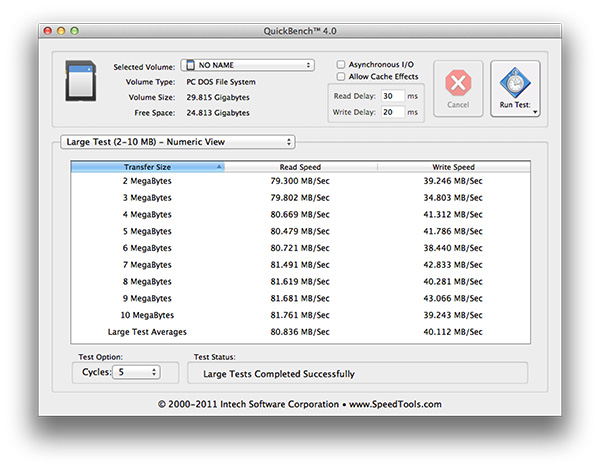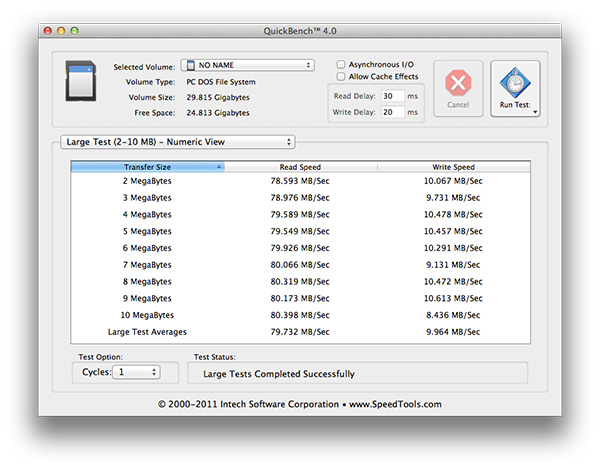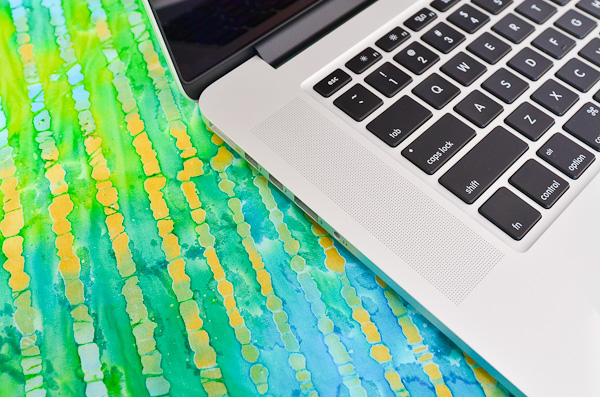The next-gen MacBook Pro with Retina Display Review
by Anand Lal Shimpi on June 23, 2012 4:14 AM EST- Posted in
- Mac
- Apple
- MacBook Pro
- Laptops
- Notebooks
WiFi Performance
The next-gen MacBook Pro is equipped with a decidedly this-gen wireless stack. In other words it uses the same 3x3:3 WiFi solution that was present in the 2011 MacBook Pro and is present in the non-Retina 2012 MacBook Pro as well: Broadcom’s BCM4331. The wireless behavior characteristics are a bit different since this is a physically different chassis, but we’re still dealing with a 3-stream 802.11n solution - not 802.11ac. All three antennas are located in the Retina Display’s housing.
We have seen Apple be conservative with component choices in the past. Deciding to stick with Samsung’s 45nm LP process for the A5X instead of embracing 32nm LP sooner with the 3rd gen iPad is one example that comes to mind. Like a good silicon company Apple appears to mitigate risk in design by sticking with known-good components wherever possible. Major changes to the industrial design are typically paired with comparatively minor silicon changes, and other components are kept as static as possible so long as they don’t overly compromise experience. While 802.11ac dongles and routers are just arriving today, Apple likely froze the Retina MBP’s wireless configuration quite a while ago. Rather than be caught shipping potentially unratified hardware, Apple went the safe route and stuck with 802.11n.

That’s not to say Apple’s wireless implementation is bad. The 15-inch MacBook Pro has been one of the best behaved notebooks on wireless that I’ve had the pleasure of using. The MacBook Pro with Retina Display is no different. Just like before, the best case negotiated physical rate is 450Mbps when paired with a 5GHz 3x3 access point. Unobstructed, within a couple of feet of the AP, I measured as much as 230Mbps to the Retina MacBook Pro. I tested at three different distances from the AP, through walls and on both 2.4GHz and 5GHz bands. Overall performance seemed comparable to the standard 15-inch MacBook Pro, although it’s definitely faster in some areas and slower in others.
| Location 1 | Location 2 | Location 3 | |
| 2011 MacBook Pro (2.4GHz) | 124.0 Mbps | 12.6 Mbps | 61.6 Mbps |
| Retina MacBook Pro (2.4GHz) | 117.9 Mbps | 87.6 Mbps | 44.0 Mbps |
| 2011 MacBook Pro (5GHz) | 186.8 Mbps | 154.6 Mbps | 24.7 Mbps |
| Retina MacBook Pro (5GHz) | 227.7 Mbps | 156.8 Mbps | 33.7 Mbps |
The second test location consistently performed poorly on the 2011 MBP, only on 2.4GHz however. For the most part there were no real surprises otherwise.
The SD Card Reader
It was our own Brian Klug who clued me into the horrible behavior of the 2011 MacBook Pro’s SD card reader. Depending on the SD card used, the integrated SD card reader either performed admirably or was the most frustrating part of the Mac experience. Out of the three SD cards I frequently use: a Patriot LX series card, a Transcend and a new UHS-I Patriot EP Pro, only the Transcend card actually works remotely well with the 2011 chassis. Even then, it’s not perfect. I usually have to insert and remove the card at least once before the reader will recognize it. The LX and EP Pro on the other hand are measurably worse. To get the EP Pro to work in the 2011 MBP’s reader I usually have to push the card in then apply upward or downward force to the exposed edge of the card to get it to read properly. Even then it’ll usually disappear from OS X or be present but read at bytes per second. I doubt this is the fault of the card itself but rather the latest example of incompatibility with the horrible SD card reader in last year’s MacBook Pro.
At least with the cards I’ve tested, the Retina MacBook Pro exhibits none of these issues. Over dozens of insertions I had no issues reading from or writing to all three of these cards, including the problematic ones. I ran a Quick Bench test on the EP Pro as it’s the fastest of the lot and came away with reasonable performance as well. Roughly 80MB/s reads and 40MB/s writes. The numbers are shy of Patriot’s 90/50 spec but quite good.
One of the times I was able to get the EP Pro working in the 2011 MacBook Pro I managed to squeeze in a single Quick Bench run. Read performance was almost identical at 80MB/s, but write performance was far lower at only 10MB/s:
Shortly after the test completed I could no longer write to the drive in the 2011 MBP so I suspect the card reader was acting up again. Needless to say, if you like using SD cards with your MacBook Pro the Retina Display model appears to be much better. That’s not to say there couldn’t be other incompatibilities, but in everything I tested it looks like this problem is finally fixed.
Better Speakers and Dual Mics
Apple is proud of its new speaker design in the Retina MacBook Pro. There’s not a whole lot you can do for tiny laptop speakers but despite shrinking the overall volume of the chassis, Apple has managed to deliver much better sound out of the new speakers in the rMBP. Like most of the upgrades to the next-gen MacBook Pro, you really need to do an A/B comparison to appreciate the difference. And keep your expectations in line with reality, a good set of external speakers are always going to sound better. With that said, the new speakers definitely deliver a fuller, more rich sound than their predecessor. You can still tell you’re listening to some form of integrated speakers, but now they sound distinctly less like they’re coming from a inside a notebook.
In preparation for Mountain Lion's arrival with dictation support, Apple outfitted the next-gen MacBook Pro with dual microphones in order to better focus on your spoken voice and not on background noise. In practice the new mics work reasonably well, rejecting moderate volume background noise. Loud music nearby will still cause interference and as always, accurate dictation requires more than just good quality source audio to get right.













471 Comments
View All Comments
OCedHrt - Sunday, June 24, 2012 - link
1) That's probably Canada. It is $1599 base in US for a while now and I got mine for $1100 after tax.2) Another Canada thing. But I agree, Sony is too inflexible.
3) That is by design. There is a video online with an interview where they explain it. This means you can grab your laptop by the screen and not risk damaging the hinges / screen. If you grabbed your MBP Retina by the display I'd be wary of breaking it.
ThreeDee912 - Saturday, June 23, 2012 - link
There's more to a computer than its hardware spec sheet.You can rattle off a laptop spec sheet with a good CPU, GPU, SSD, screen, etc., but if they're not integrated very well with everything else, or have mediocre software support, you can't always take advantage of those specs without some tacky workarounds.
gstrickler - Sunday, June 24, 2012 - link
^^^ I'll second that. Also, the right balance of specs matters more than "this spec is greater than that spec".If the keyboard, trackpad, or display sucks, you'll hate the computer no mater what the specs say. If it's too fragile, or heavy, or cumbersome, you won't want to carry it. If the software is slow and bloated, it won't matter that you've got 8GB RAM and a quad core i7, it can still feel sluggish.
The satisfaction with a computer is far more than just it's specs, or individual components, or even it's operating system. It's having the right combination of everything.
OCedHrt - Sunday, June 24, 2012 - link
1) This is dependent on user. i don't care about the 1" vertical, it's really the # of pixels that matter.2) The previous Z had discrete built in. The purpose of making it external is to achieve the 2.5 lb form factor. Sony once had a 11" 1.6 lb netbook. That is literally the holy grail in terms of weight for a portable laptop. The move to external discrete is really a step in that direction.
3) You can output more than 1920x1080 on HDMI.
4) 15" is too big for me, even at 2.5 lbs. Not everyone wants a huge screen on their lap - that's why I have a monitor on the desk.
5) Yes, at 2.5 lbs and 13", there's limited space for heat dispersion.
maratus - Sunday, June 24, 2012 - link
Unfortunately, Z tops at 1920x1200 through HDMI or single link DVI on the dock station. It was a dealbraker. Now rMBP ability to drive 2x 2560x1600 and 1x 1920x1200 is simply overkill for me, I'm still confused why did Sony stuck with HDMI only and didn't even bother to provide DP, mDP or 2L DVI as a second port.OCedHrt - Monday, June 25, 2012 - link
That's typical Sony (Japanese) stupidity.Chava - Friday, June 29, 2012 - link
That's typical Japanese stupidity...Yeah for some reason you thought that was acceptable.
Solandri - Saturday, June 23, 2012 - link
The chassis isn't thinner than the 13" 2010 MBP (it tapers from 1.0-1.3" vs the MBP's 0.95"). Its other two dimensions are smaller though (12.4" x 8.3" vs 12.8" x 8.9"), and it's lighter (lighter than the 2010 Macbook Air in fact) at 2.9 lbs (some models were 3.04 lbs, never figured out why). Sony managed this by using a lot of carbon fiber and a really thin screen. So it's not as stiff as the solid block of aluminum that the MBP used. But the keyboard bezel is solid aluminum making it very stiff.http://asia.cnet.com/sony-vaio-z-sports-worlds-fir...
http://www.pcpro.co.uk/reviews/laptops/355384/sony...
Here's the only marketing brochure I could find for the model being discussed (in French):
http://www.mgmi.fr/docs/pdfprod/VPC-Z11Z9E-B.pdf
OCedHrt - Sunday, June 24, 2012 - link
That's the 2008 Z. 2008. The 2011 Z is a non tapered design:13.0" x 0.66" x 8.27" (WxHxD)
330mm x 16.8mm x 210mm
The MBP is 50% thicker than the Z. It's understandable given that it is 15" instead of 13".
Freakie - Sunday, June 24, 2012 - link
http://www.tomshardware.com/news/sony-vaio-z-quad-...Here you go. THIS is true innovation. Sony did amazing work with this version of the Z to get all the functionality of a bigger laptop into a tiny package. It is even more impressive when you think about how old, hot, and power hungry the CPU/GPU was back then. Sony has innovated much more in the laptop industry than Apple has, in my opinion. Though I still wouldn't want a Sony like this just like I wouldn't want an Apple like the rMBP (user upgradability and repairability is virtually non-existant, which is an instant deal breaker for me, it was hard enough buying a laptop with a 540M integrated onto the mobo, could never buy a laptop that didn't even let you upgrade storage)
Here's a more detailed teardown: http://translate.google.com/translate?js=y&pre...